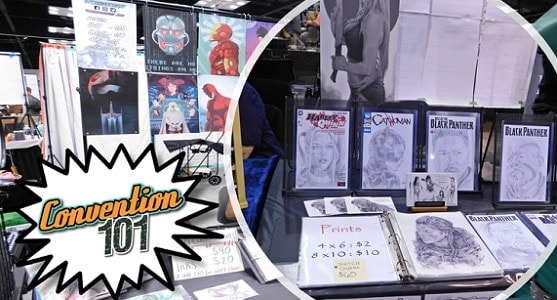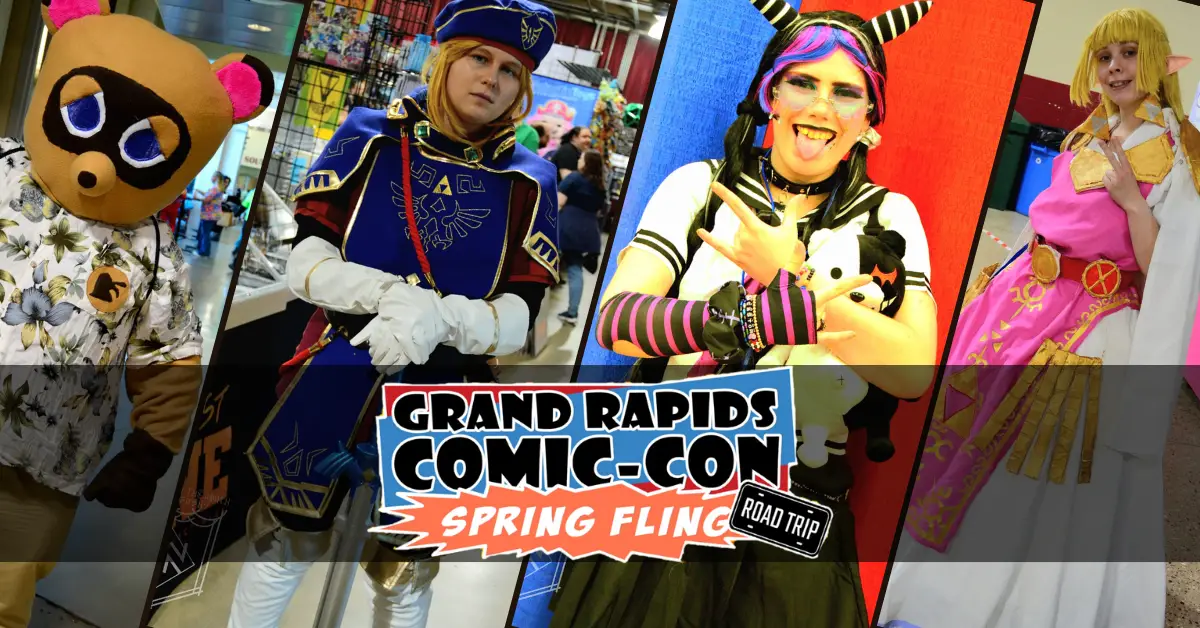This is part 4 of our Conventions organizing series of articles.
The artists are obvious; they are the ones with pads of paper, ink (or paint) stains on their fingers, and frequently have a stack of colored markers at hand. You usually have them segregated over to what is commonly known as Artist Alley.
Some of them are well-known and have a long history, others are fairly new and trying to make a name for themselves. They are all trying to sell their artwork and their names. Most of the artists have paid for space and are there to sell their style and draw in the patrons.
Much like vendors, if you don’t treat them nicely and make things easy and affordable for them, then they probably won’t return. Artists talk to each other and frequently have a fan following. If something goes wrong, then the odds are pretty good that they will let the world know.
Clear contract – This is one factor that can not be stressed enough. You need a very clear contract that lays out expectations on both sides and it should be a different contract than what you had for the vendors. This is a binding document that protects both sides. The specific details of the contract are up to you, but a few key points are:
- Cost and size of table, including height restrictions.
- Local tax requirements
- Local insurance requirements
- Location of table (often, this is decided later in the process)
- Medium restrictions – yes, puppets and bracelets might be art, but their creation typically falls into the realm of crafter. Are you allowing crafters into Artist Alley, putting them elsewhere, or keeping them out?
- What is banned for sale and/or suggested to be kept under cover (nudes, excessive violence, etc.)
- Penalty for term violations
- Load in/load out time and capabilities (ramp, freight elevator, dollies, lifts, etc.)
- What you provide (table size, amount of chairs, draping, etc.)
Table locations – Think carefully about how you will arrange your artists. If the artist is a big name draw, that means they will potentially have a line. If you put these artists in the middle of a row, that means the line is blocking the tables of other artists. This causes huge problems for the other artists.
- It blocks their table from other people, preventing sales, and impeding their ability to be seen
- All they get to see is a line of butts, as people stand in front of them
- The line prevents anyone from getting in or out of the table; this means no bathroom or food breaks
- Tightly packed lines of people get bored, lean on things, and rest items they are carrying. The nearest resting surface is the artist’s table. This means that more items are likely to get stolen or damaged. It may be unintentional, but it happens.
- The plus side to this line is that the artists have a captive audience and can occasionally make a sale or develop a new fan.
Clear map layout – Provide a detailed layout to each of the artists so they can easily locate their table. This also allows them to tell their fan base where to find them. This is good for you because that means they are advertising for you. Also highlight on the map where load in/load out is.
Load in/Load Out – For some artists, this is a simple process; they have a crate or two of materials and simply walk it in the front door. Others have a more elaborate setup that may require them to unload their vehicle. Either way, they need to know what is allowed during loading and setup time, where it is, and when it is. Let the artists know ahead of time if the location requires that they use the facility’s personnel for any major set-up, especially if it costs extra. If the artists can simply carry in and set-up their own displays, they are more likely to attend your event. If larger displays require facility employees, they may avoid your event or change how they display their art to avoid the requirement.

Room to Move – A long row of artist tables displaying art may look nice and allow you to fit in a lot more tables, but how are the artists supposed to get out? Too often artists are forced to climb over or under tables to get to the bathroom, get food, interact with a fan, or to even fix the front of their display. There are some simple ways to make it easier:
- Leave a half table width between tables every three to four tables, or
- Provide an ‘alley’ between between back-to-back artists’ tables that allow artists to get out the back way, but even this is inconvenient when the ‘alley’ is a long row.
- Allow some space behind the tables so each artist can put up their banners or walls, and if you are putting artist rows back-to-back, ensure there is enough room for everyone to divide the space. Using tape to mark the division lines is one way to ensure that artists don’t encroach on each other.
Security – Nobody wants their stuff stolen, it’s a profit loss. If the convention is over multiple days, then their stuff is (most likely) left at at the tables.
- Are you providing security overnight for it?
- Who else has access to the room?
- Are there cameras? And do the cameras actually work?
- What is the procedure if they do find that things have been stolen?
Breaks/food access – Artists are typically solo at their tables. If an artist needs to use the bathroom or grab food, they must leave their table. This can be a problem. An artist must rely on the kindness of their neighbors as they make a mad dash across the hall to stand in a half-hour bathroom line, I feel sorry for any of them that decide to grab food.
These necessity breaks mean that they are losing sales and possibly having merchandise lifted while they are gone. As a con organizer, you can provide a runner to deliver food, or to even provide one or two scheduled ‘potty break’ coverages. To avoid the artists being gone for too long on their breaks, let them use the same bathroom as the one you put aside for your guests (if you gave them a separate one, that is). As for food, why not have someone with a cart walk the aisles selling various portable food stuffs? Just make sure that you have some healthy options on there. Do a few of these simple things and artists will want to return.
Copyright violations – This is a very tricky field to negotiate when it comes to art. You don’t necessarily know what each artist has license to sell or what is their original work, but you can be on the lookout for obvious violations. Don’t accommodate them. If someone points out that vendor ‘A” is selling unlicensed or copied art (and can prove it), then get them off your floor.
Schedule – You have a schedule for your patrons with various show and panel times, but you also need to provide the schedule to your artists. Schedules are important, especially if you expect some of the artists to attend certain panels. They can’t show up if they don’t know where or when to appear. A map on the schedule makes it easier for them to figure out where they need to be. And ALWAYS make sure you alert them to any schedule changes.
Summary
This is just a basic overview of some of the things a convention organizer needs to consider for their vendors. Not everything applies to every convention, they all have their own unique set of circumstances.
To find out more about setting up a convention, check out our handy page on Convention Running 101.
And just to reiterate our point – These are in no way the definitive be-all and end-all rules for a convention. They are only a guideline…a place to start.
They don’t apply to all conventions, and not every convention is big enough or capable of dealing with some of the things we discuss, but it doesn’t hurt to keep some of them in mind.
If you have your own additions to this, please put them in the comments.
Disclaimer:
I do not run conventions, I have not run conventions, and I have no plans to run a convention. I’ve seen how much work they are.
These articles are based off my own experience, those of vendors, agents, artists, volunteers, and several convention organizers I have spoken to over the last several years.






2 thoughts on “Convention Organizing 101 – The Artists”
Comments are closed.